Ultra-High Resolution 9.4T Brain MRI Segmentation via a Newly Engineered Multi-Scale Residual Nested U-Net with Gated Attention
Abstract
1. Introduction
1.1. Existing Deep Learning Frameworks
1.2. Volumetry in Brain MRI
1.3. Clinical Importance of 9.4T
2. Materials and Methods
2.1. Study Design
2.2. Image Acquisition
2.3. Dataset Preprocessing
2.4. Neural Network Engineering
2.5. Training Parameters
3. Results
3.1. Dice and SSIM Evaluation
3.2. Whole Brain Volumetry
3.3. Qualitative Analysis
3.4. Statistical Analysis and Memory Efficiency
4. Discussion
5. Conclusions
Author Contributions
Funding
Institutional Review Board Statement
Informed Consent Statement
Data Availability Statement
Acknowledgments
Conflicts of Interest
References
- Marek, J.; Bachurska, D.; Wolak, T.; Borowiec, A.; Sajdek, M.; Maj, E. Quantitative brain volumetry in neurological disorders: From disease mechanisms to software solutions. Pol. J. Radiol. 2025, 90, e299–e306. [Google Scholar] [CrossRef] [PubMed] [PubMed Central]
- Kabasawa, H. MR Imaging in the 21st Century: Technical Innovation over the First Two Decades. Magn. Reson. Med. Sci. 2022, 21, 71–82. [Google Scholar] [CrossRef] [PubMed] [PubMed Central]
- Glasser, M.F.; Smith, S.M.; Marcus, D.S.; Andersson, J.L.; Auerbach, E.J.; Behrens, T.E.; Coalson, T.S.; Harms, M.P.; Jenkinson, M.; Moeller, S.; et al. The Human Connectome Project’s neuroimaging approach. Nat. Neurosci. 2016, 19, 1175–1187. [Google Scholar] [CrossRef] [PubMed] [PubMed Central]
- Balchandani, P.; Naidich, T.P. Ultra-High-Field MR Neuroimaging. AJNR Am. J. Neuroradiol. 2015, 36, 1204–1215. [Google Scholar] [CrossRef] [PubMed] [PubMed Central]
- Ladd, M.E.; Bachert, P.; Meyerspeer, M.; Moser, E.; Nagel, A.M.; Norris, D.G.; Schmitter, S.; Speck, O.; Straub, S.; Zaiss, M. Pros and cons of ultra-high-field MRI/MRS for human application. Prog. Nucl. Magn. Reson. Spectrosc. 2018, 109, 1–50. [Google Scholar] [CrossRef] [PubMed]
- Vaughan, T.; DelaBarre, L.; Snyder, C.; Tian, J.; Akgun, C.; Shrivastava, D.; Liu, W.; Olson, C.; Adriany, G.; Strupp, J.; et al. 9.4T human MRI: Preliminary results. Magn. Reson. Med. 2006, 56, 1274–1282. [Google Scholar] [CrossRef] [PubMed] [PubMed Central]
- Donnay, C.; Dieckhaus, H.; Tsagkas, C.; Gaitán, M.I.; Beck, E.S.; Mullins, A.; Reich, D.S.; Nair, G. Pseudo-Label Assisted nnU-Net enables automatic segmentation of 7T MRI from a single acquisition. Front. Neuroimaging 2023, 2, 1252261. [Google Scholar] [CrossRef] [PubMed] [PubMed Central]
- Ronneberger, O.; Fischer, P.; Brox, T. U-Net: Convolutional networks for biomedical image segmentation. arXiv 2015, arXiv:1505.04597. [Google Scholar] [CrossRef]
- Du, W.; Yin, K.; Shi, J. Dimensionality Reduction Hybrid U-Net for Brain Extraction in Magnetic Resonance Imaging. Brain Sci. 2023, 13, 1549. [Google Scholar] [CrossRef] [PubMed] [PubMed Central]
- Oktay, O.; Schlemper, J.; Folgoc, L.L.; Lee, M.; Heinrich, M.; Misawa, K.; Mori, K.; McDonagh, S.; Hammerla, N.Y.; Kainz, B.; et al. Attention U-Net: Learning where to look for the pancreas. arXiv 2018, arXiv:1804.03999. [Google Scholar] [CrossRef]
- Kim, J.; Lee, J.K.; Lee, K.M. Accurate image super-resolution using very deep convolutional networks (Version 2). arXiv 2016, arXiv:1511.04587. [Google Scholar] [CrossRef]
- Alom, M.Z.; Yakopcic, C.; Hasan, M.; Taha, T.M.; Asari, V.K. Recurrent residual U-Net for medical image segmentation. J. Med. Imaging 2019, 6, 014006. [Google Scholar] [CrossRef] [PubMed] [PubMed Central]
- Zhou, Z.; Siddiquee, M.M.R.; Tajbakhsh, N.; Liang, J. UNet++: A Nested U-Net Architecture for Medical Image Segmentation. In Deep Learning in Medical Image Analysis and Multimodal Learning for Clinical Decision Support; Springer: Cham, Switzerland, 2018; Volume 11045, pp. 3–11. [Google Scholar] [CrossRef] [PubMed] [PubMed Central]
- Schuff, N.; Woerner, N.; Boreta, L.; Kornfield, T.; Shaw, L.M.; Trojanowski, J.Q.; Thompson, P.M.; Jack, C.R., Jr.; Weiner, M.W.; Alzheimer’s Disease Neuroimaging Initiative. MRI of hippocampal volume loss in early Alzheimer’s disease in relation to ApoE genotype and biomarkers. Brain 2009, 132 Pt 4, 1067–1077. [Google Scholar] [CrossRef] [PubMed] [PubMed Central]
- Marciniewicz, E.; Pokryszko-Dragan, A.; Podgórski, P.; Małyszczak, K.; Zimny, A.; Kołtowska, A.; Budrewicz, S.; Sąsiadek, M.; Bladowska, J. Quantitative magnetic resonance assessment of brain atrophy related to selected aspects of disability in patients with multiple sclerosis: Preliminary results. Pol. J. Radiol. 2019, 84, e171–e178. [Google Scholar] [CrossRef] [PubMed] [PubMed Central]
- Lauer, A.; Speroni, S.L.; Patel, J.B.; Regalado, E.; Choi, M.; Smith, E.; Kalpathy-Kramer, J.; Caruso, P.; Milewicz, D.M.; Musolino, P.L. Cerebrovascular disease progression in patients with ACTA2 Arg179 pathogenic variants. Neurology 2021, 96, e538–e552. [Google Scholar] [CrossRef]
- Stelmokas, J.; Yassay, L.; Giordani, B.; Dodge, H.H.; Dinov, I.D.; Bhaumik, A.; Sathian, K.; Hampstead, B.M. Translational MRI Volumetry with NeuroQuant: Effects of Version and Normative Data on Relationships with Memory Performance in Healthy Older Adults and Patients with Mild Cognitive Impairment. J. Alzheimer’s Dis. 2017, 60, 1499–1510. [Google Scholar] [CrossRef] [PubMed] [PubMed Central]
- Dorfner, F.J.; Patel, J.B.; Kalpathy-Cramer, J.; Gerstner, E.R.; Bridge, C.P. A review of deep learning for brain tumor analysis in MRI. npj Precis. Oncol. 2025, 9, 2. [Google Scholar] [CrossRef] [PubMed]
- Patel, J.; Chang, K.; Ahmed, S.R.; Jang, I.; Kalpathy-Cramer, J. Opportunities and challenges for deep learning in brain lesions. In Brainlesion: Glioma, Multiple Sclerosis, Stroke and Traumatic Brain Injuries (BrainLes 2021); Lecture Notes in Computer Science; Crimi, A., Bakas, S., Eds.; Springer: Cham, Switzerland, 2022; Volume 12962, pp. 25–36. [Google Scholar] [CrossRef]
- Patel, J.; Chang, K.; Hoebel, K.; Gidwani, M.; Arun, N.; Gupta, S.; Aggarwal, M.; Singh, P.; Rosen, B.R.; Gerstner, E.R.; et al. Segmentation, Survival Prediction, and Uncertainty Estimation of Gliomas from Multimodal 3D MRI Using Selective Kernel Networks. In Brainlesion: Glioma, Multiple Sclerosis, Stroke and Traumatic Brain Injuries (BrainLes 2020); Lecture Notes in Computer Science; Crimi, A., Bakas, S., Eds.; Springer: Cham, Switzerland, 2021; Volume 12659. [Google Scholar] [CrossRef]
- Prasanna, P.; Patel, J.; Partovi, S.; Madabhushi, A.; Tiwari, P. Radiomic features from the peritumoral brain parenchyma on treatment-naïve multi-parametric MR imaging predict long versus short-term survival in glioblastoma multiforme: Preliminary findings. Eur. Radiol. 2017, 27, 4188–4197. [Google Scholar] [CrossRef] [PubMed]
- Beig, N.; Patel, J.; Prasanna, P.; Partovi, S.; Varadan, V.; Madabhushi, A.; Tiwari, P. Radiogenomic analysis of hypoxia pathway reveals computerized MRI descriptors predictive of overall survival in glioblastoma. In Medical Imaging 2017: Computer-Aided Diagnosis; Armato, S.G., Petrick, N.A., Eds.; SPIE: Bellingham, WA, USA, 2017; Volume 10134, p. 101341U. [Google Scholar] [CrossRef]
- Patel, J.; Ahmed, S.R.; Chang, K.; Singh, P.; Gidwani, M.; Hoebel, K.; Kim, A.; Bridge, C.; Teng, C.; Li, X.; et al. A Deep Learning Based Framework for Joint Image Registration and Segmentation of Brain Metastases on Magnetic Resonance Imaging. In Machine Learning Research, Proceedings of the 8th Machine Learning for Healthcare Conference, New York, NY, USA, 11–12 August 2023; PMLR: Brookline, MA, USA, 2023; Volume 219, pp. 565–587. Available online: https://proceedings.mlr.press/v219/patel23a.html (accessed on 1 September 2025).
- Peng, J.; Kim, D.D.; Patel, J.B.; Zeng, X.; Huang, J.; Chang, K.; Xun, X.; Zhang, C.; Sollee, J.; Wu, J.; et al. Deep learning-based automatic tumor burden assessment of pediatric high-grade gliomas, medulloblastomas, and other leptomeningeal seeding tumors. Neuro-Oncology 2022, 24, 289–299. [Google Scholar] [CrossRef] [PubMed]
- Leung, J.-H.; Karmakar, R.; Mukundan, A.; Lin, W.-S.; Anwar, F.; Wang, H.-C. Technological Frontiers in Brain Cancer: A Systematic Review and Meta-Analysis of Hyperspectral Imaging in Computer-Aided Diagnosis Systems. Diagnostics 2024, 14, 1888. [Google Scholar] [CrossRef]
- Mukundan, A.; Gupta, D.; Karmakar, R.; Wang, H.C. Transforming pediatric imaging: The role of four-dimensional flow magnetic resonance imaging in quantifying mesenteric blood flow. World J. Radiol. 2025, 17, 106582. [Google Scholar] [CrossRef] [PubMed] [PubMed Central]
- Robinson-Weiss, C.; Patel, J.; Bizzo, B.C.; Glazer, D.I.; Bridge, C.P.; Andriole, K.P.; Dabiri, B.; Chin, J.K.; Dreyer, K.; Kalpathy-Cramer, J.; et al. Machine learning for adrenal gland segmentation and classification of normal and adrenal masses at CT. Radiology 2022, 306, 285–295. [Google Scholar] [CrossRef]
- Ilesanmi, A.E.; Ilesanmi, T.; Gbotoso, G.A. A systematic review of retinal fundus image segmentation and classification methods using convolutional neural networks. Healthc. Anal. 2023, 4, 100261. [Google Scholar] [CrossRef]
- Çallı, E.; Sogancioglu, E.; van Ginneken, B.; van Leeuwen, K.G.; Murphy, K. Deep learning for chest X-ray analysis: A survey. Med. Image Anal. 2021, 72, 102125. [Google Scholar] [CrossRef] [PubMed]
- Mahler, L.; Steiglechner, J.; Bender, B.; Lindig, T.; Ramadan, D.; Bause, J.; Birk, F.; Heule, R.; Charyasz, E.; Erb, M.; et al. Submillimeter Ultra-High Field 9.4 T Brain MR Image Collection and Manual Cortical Segmentations. Sci. Data 2025, 12, 635. [Google Scholar] [CrossRef]
- Billot, B.; Greve, D.N.; Puonti, O.; Thielscher, A.; Van Leemput, K.; Fischl, B.; Dalca, A.V.; Iglesias, J.E. ADNI SynthSeg: Segmentation of brain MRI scans of any contrast and resolution without retraining. Med. Image Anal. 2023, 86, 102789. [Google Scholar] [CrossRef] [PubMed] [PubMed Central]
- Marcus, D.S.; Wang, T.H.; Parker, J.; Csernansky, J.G.; Morris, J.C.; Buckner, R.L. Open Access Series of Imaging Studies (OASIS): Cross-sectional MRI data in young, middle aged, nondemented, and demented older adults. J. Cogn. Neurosci. 2007, 19, 1498–1507. [Google Scholar] [CrossRef]
- Chen, H.; Zendehdel, N.; Leu, M.C.; Yin, Z. A gaze-driven manufacturing assembly assistant system with integrated step recognition, repetition analysis, and real-time feedback. Eng. Appl. Artif. Intell. 2025, 144, 110076. [Google Scholar] [CrossRef]
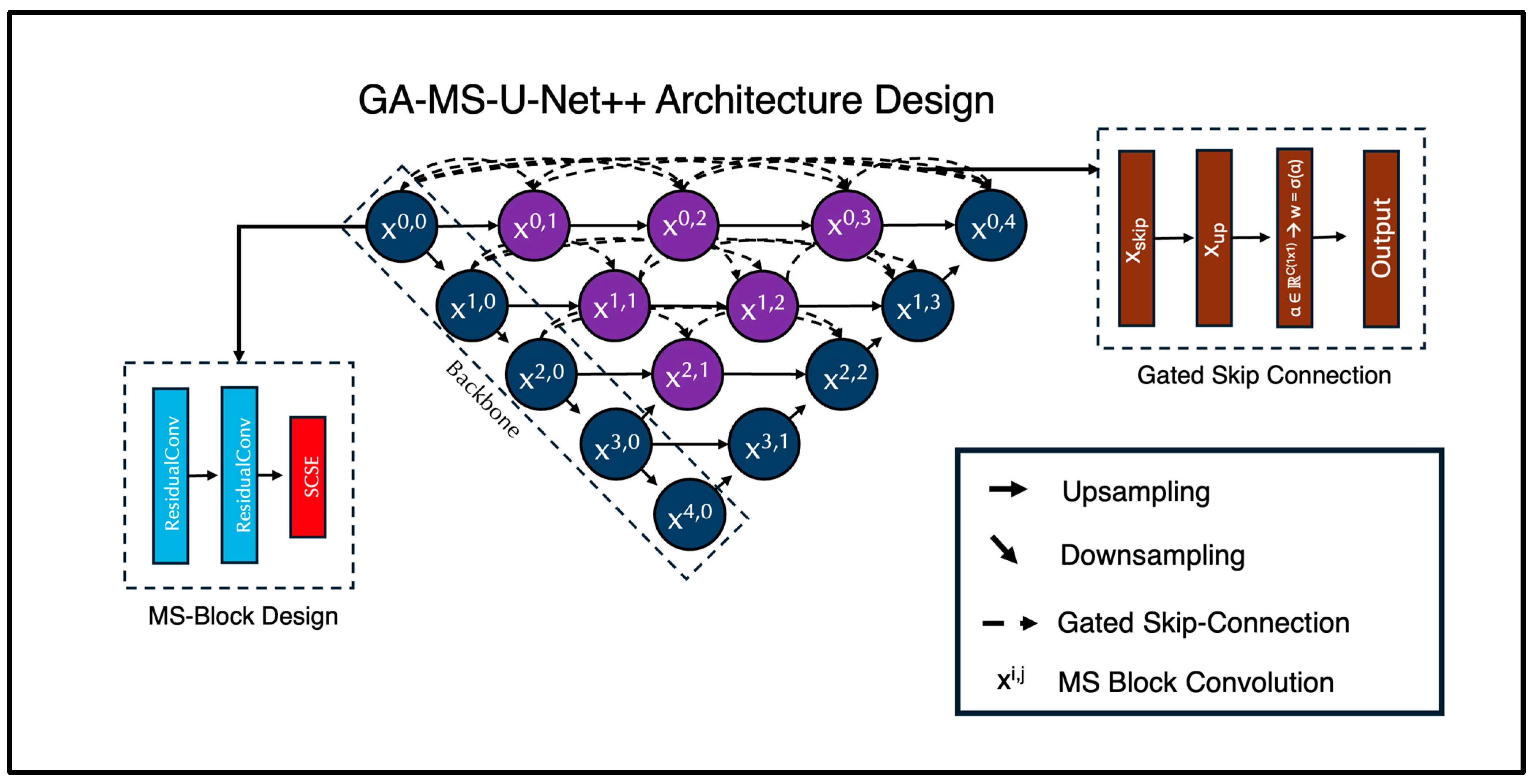
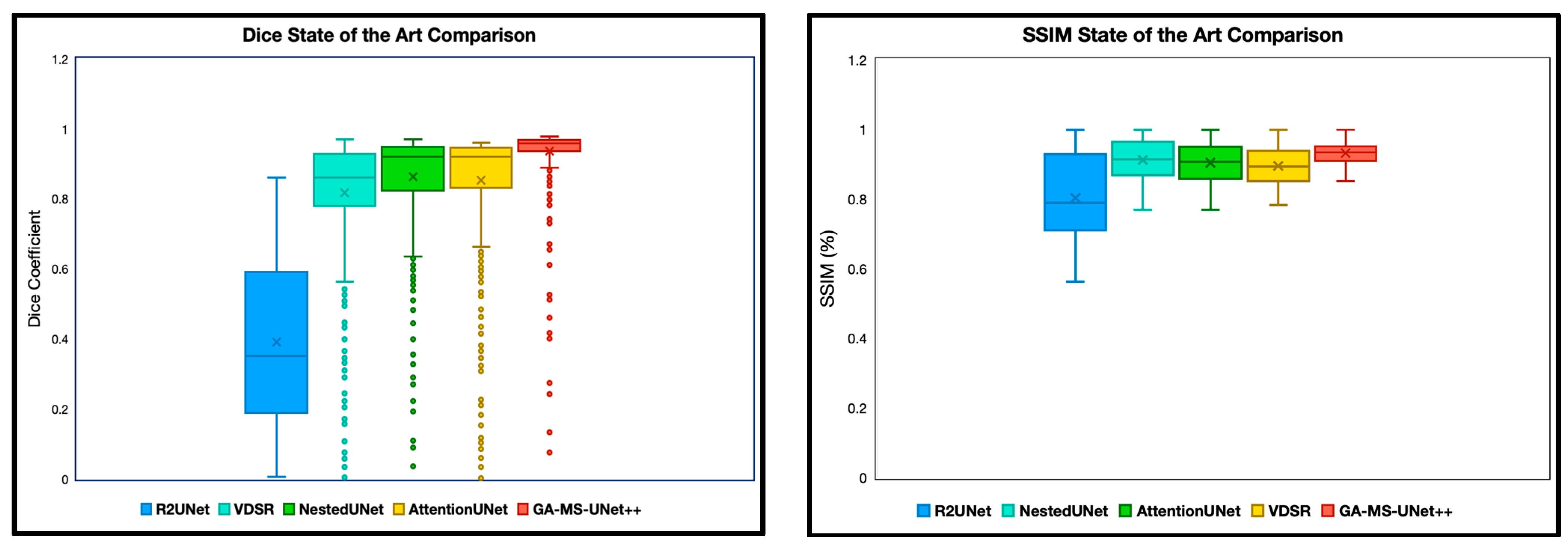
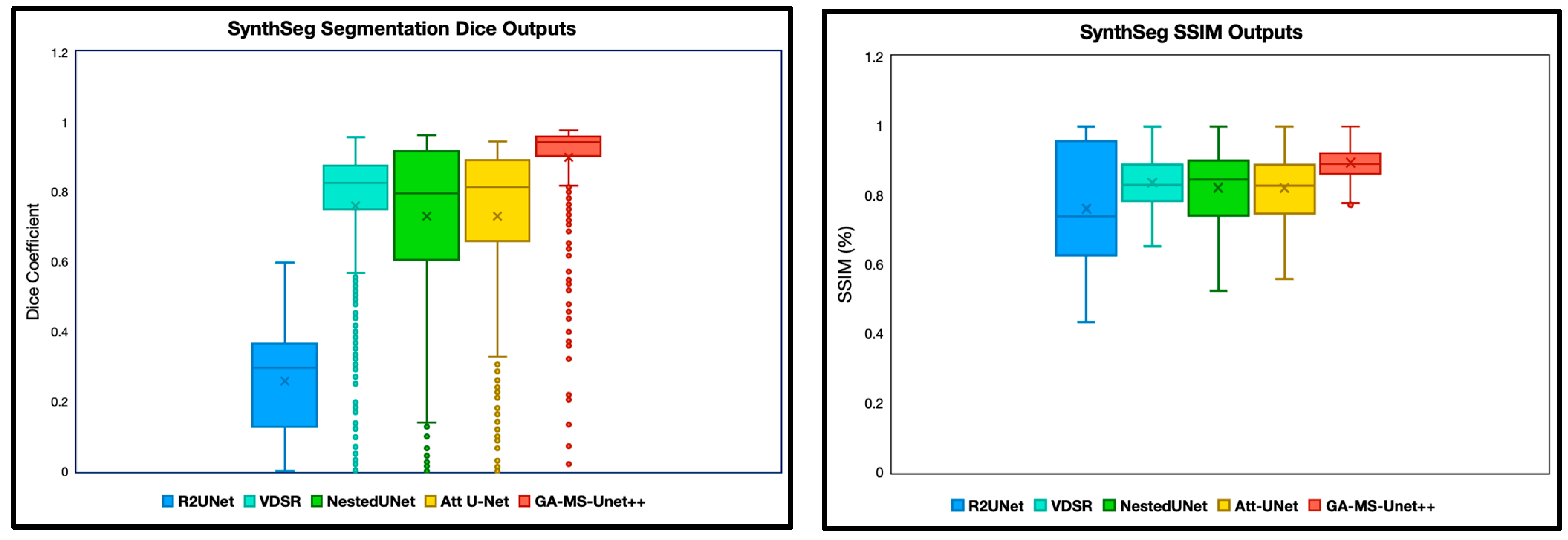
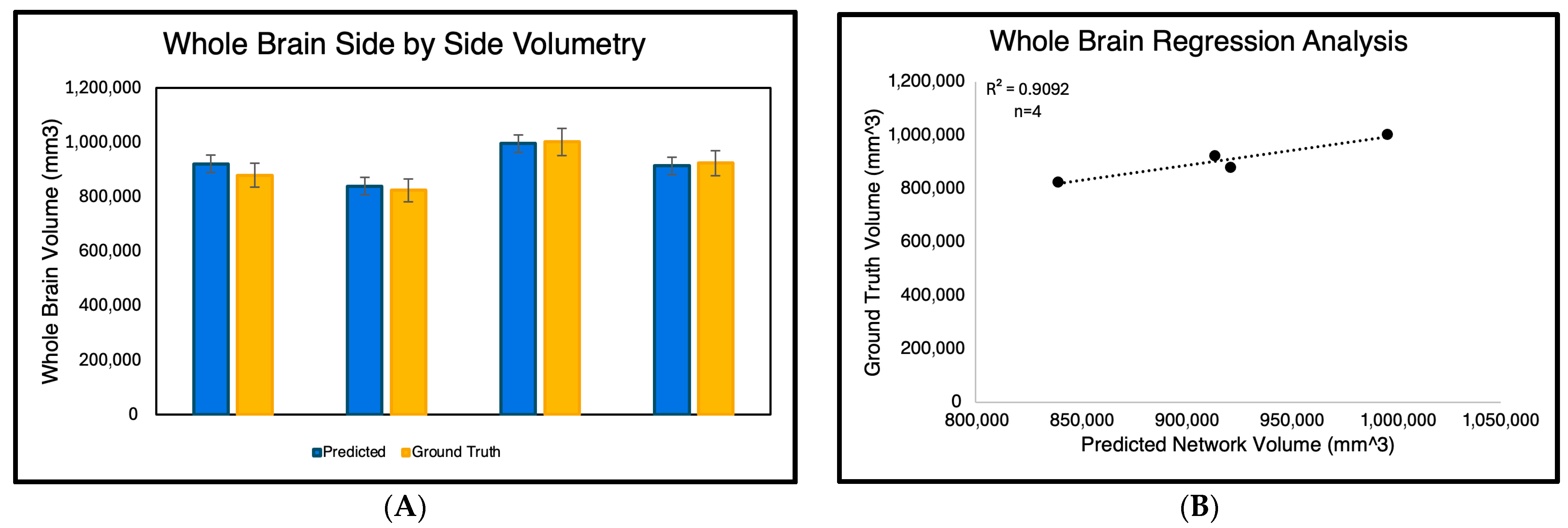
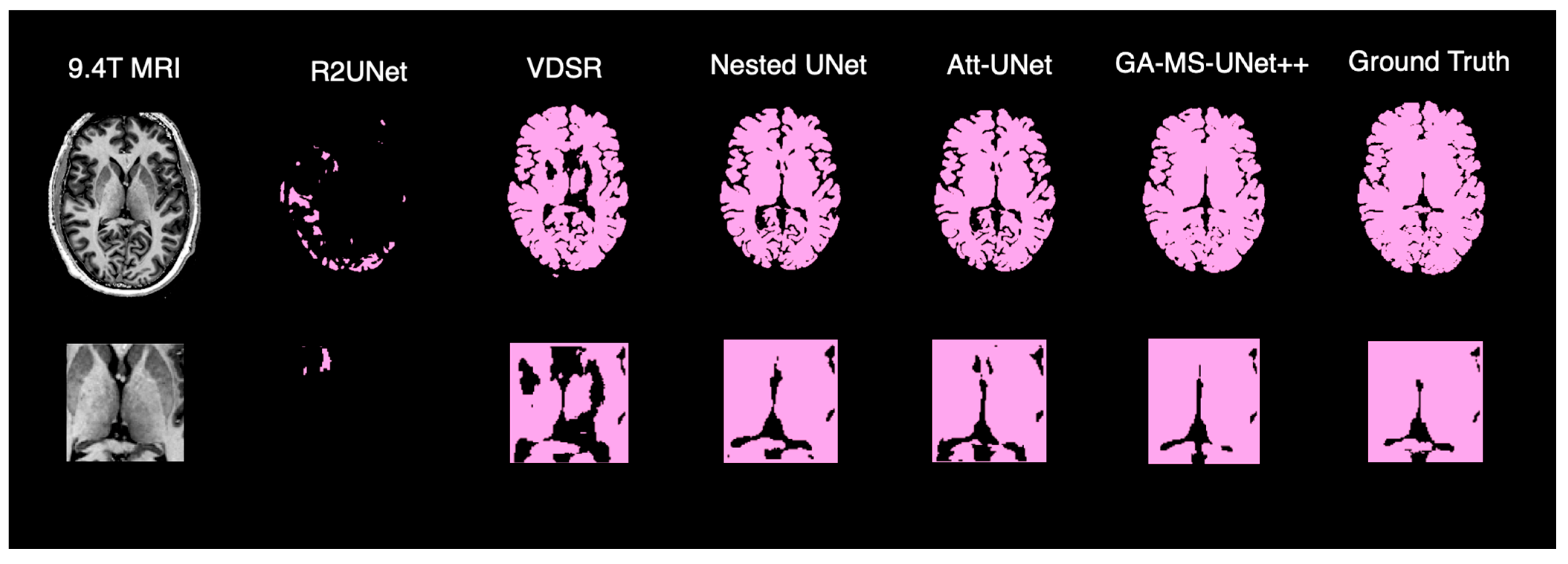

| R2UNet | VDSR | Nested U-Net | Attention U-Net | GA-MS-UNet++ | |
|---|---|---|---|---|---|
| Accuracy | 0.8039 | 0.9081 | 0.9434 | 0.9305 | 0.9729 |
| Precision | 0.8877 | 0.9721 | 0.9692 | 0.9725 | 0.9002 |
| Recall | 0.2175 | 0.4406 | 0.6469 | 0.5525 | 0.9400 |
| GA-MS-UNet++ | p-Value |
|---|---|
| R2UNet | <1 × 10−5 |
| VDSR | <1 × 10−5 |
| Nested U-Net | <1 × 10−5 |
| Attention U-Net | <1 × 10−5 |
| R2UNet | VDSR | Nested U-Net | Attention U-Net | GA-MS-UNet++ | |
|---|---|---|---|---|---|
| Inference (ms) | 105.07 | 93.87 | 97.07 | 98.93 | 119.21 |
| Parameters (M) | 39.09 | 0.66 | 9.16 | 34.88 | 14.66 |
| FLOPs | 152.70 | 43.56 | 34.62 | 66.46 | 20.83 |
| GPU Memory (GB) | 0.36 | 0.07 | 0.20 | 0.31 | 0.24 |
Disclaimer/Publisher’s Note: The statements, opinions and data contained in all publications are solely those of the individual author(s) and contributor(s) and not of MDPI and/or the editor(s). MDPI and/or the editor(s) disclaim responsibility for any injury to people or property resulting from any ideas, methods, instructions or products referred to in the content. |
© 2025 by the authors. Licensee MDPI, Basel, Switzerland. This article is an open access article distributed under the terms and conditions of the Creative Commons Attribution (CC BY) license (https://creativecommons.org/licenses/by/4.0/).
Share and Cite
Kalluvila, A.; Patel, J.B.; Johnson, J.M. Ultra-High Resolution 9.4T Brain MRI Segmentation via a Newly Engineered Multi-Scale Residual Nested U-Net with Gated Attention. Bioengineering 2025, 12, 1014. https://doi.org/10.3390/bioengineering12101014
Kalluvila A, Patel JB, Johnson JM. Ultra-High Resolution 9.4T Brain MRI Segmentation via a Newly Engineered Multi-Scale Residual Nested U-Net with Gated Attention. Bioengineering. 2025; 12(10):1014. https://doi.org/10.3390/bioengineering12101014
Chicago/Turabian StyleKalluvila, Aryan, Jay B. Patel, and Jason M. Johnson. 2025. "Ultra-High Resolution 9.4T Brain MRI Segmentation via a Newly Engineered Multi-Scale Residual Nested U-Net with Gated Attention" Bioengineering 12, no. 10: 1014. https://doi.org/10.3390/bioengineering12101014
APA StyleKalluvila, A., Patel, J. B., & Johnson, J. M. (2025). Ultra-High Resolution 9.4T Brain MRI Segmentation via a Newly Engineered Multi-Scale Residual Nested U-Net with Gated Attention. Bioengineering, 12(10), 1014. https://doi.org/10.3390/bioengineering12101014






